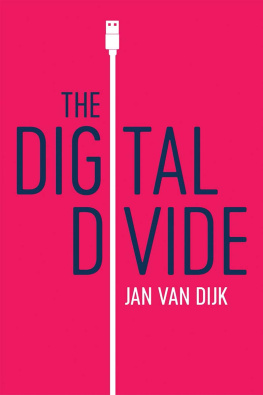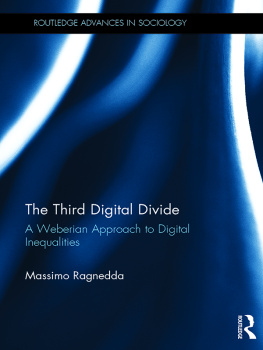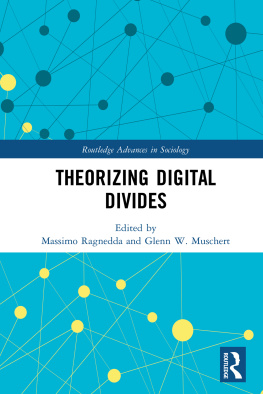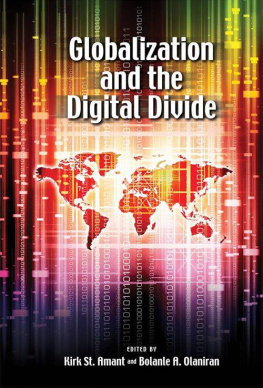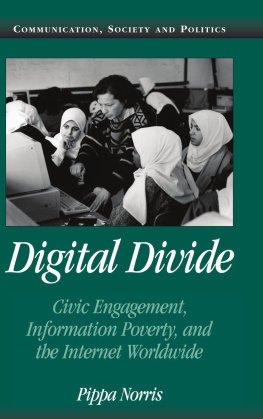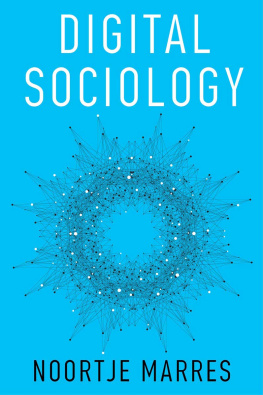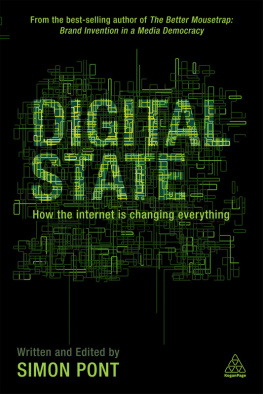
The Digital Divide
JAN VAN DIJK
polity
Copyright Jan van Dijk 2020
The right of Jan van Dijk to be identified as Author of this Work has been asserted in accordance with the UK Copyright, Designs and Patents Act 1988.
First published in 2020 by Polity Press
Polity Press
65 Bridge Street
Cambridge CB2 1UR, UK
Polity Press
101 Station Landing
Suite 300
Medford, MA 02155, USA
All rights reserved. Except for the quotation of short passages for the purpose of criticism and review, no part of this publication may be reproduced, stored in a retrieval system or transmitted, in any form or by any means, electronic, mechanical, photocopying, recording or otherwise, without the prior permission of the publisher.
ISBN-13: 978-1-5095-3446-3
A catalogue record for this book is available from the British Library.
Library of Congress Cataloging-in-Publication Data
Names: Dijk, Jan van, 1952- author.
Title: The digital divide / Jan van Dijk.
Description: Cambridge, UK ; Medford, MA : Polity, 2019. | Includes bibliographical references and index. | Summary: Contrary to optimistic visions of a free internet for all, the problem of the digital divide has persisted for close to twenty-five years. Jan van Dijk considers the state of digital inequality and what we can do to tackle it-- Provided by publisher.
Identifiers: LCCN 2019023991 (print) | LCCN 2019023992 (ebook) | ISBN 9781509534449 (hardback) | ISBN 9781509534456 (paperback) | ISBN 9781509534463 (epub)
Subjects: LCSH: Digital divide. | Computer literacy. | Internet literacy. | Equality.
Classification: LCC HM851 .D56 2019 (print) | LCC HM851 (ebook) | DDC 303.48/33--dc23
LC record available at https://lccn.loc.gov/2019023991
LC ebook record available at https://lccn.loc.gov/2019023992
The publisher has used its best endeavours to ensure that the URLs for external websites referred to in this book are correct and active at the time of going to press. However, the publisher has no responsibility for the websites and can make no guarantee that a site will remain live or that the content is or will remain appropriate.
Every effort has been made to trace all copyright holders, but if any have been overlooked the publisher will be pleased to include any necessary credits in any subsequent reprint or edition.
For further information on Polity, visit our website: politybooks.com
Acknowledgements
This book is a result of twenty-five years of research on the digital divide by me and others. Fifteen years ago I summarized my first thoughts about this topic in The Deepening Divide: Inequality in the Information Society (2005). At first sight this book looks similar. In fact, it is quite different, because here the assumptions of the former volume are tested in a large number of surveys, experiments and analyses of official statistics. The resources and appropriation theory I sketched previously has matured and is elaborated here. This book covers not only the so-called first-level digital divide research of that time (concerning physical access) but also the second level (digital skills and usage) and the third level (the outcomes of using or not using digital media). However, the inconvenient message is new: that digital inequality reinforces existing social inequality.
The framework of The Digital Divide is broad enough to summarize not only my own work and that of my staff since 2005 but also that of others. This is the first textbook on the digital divide aimed at those in higher education, especially in the social sciences and media courses covering the social aspects of digital media, and the numerous figures, tables and lists render the results accessible to all.
I am very grateful to those who have read earlier drafts and made useful comments, in particular Professor Alexander van Deursen, with whom I have collaborated on several articles and a book on digital skills. I am also indebted to the reviewers at Polity Press for their suggestions.
Finally, I want to thank my wife Ineke for her patience, support and love while her now officially retired husband is working harder than ever before.
What is the Digital Divide?
Introduction: the concept of the digital divide
In the year 2020 both the concept of and the research into the digital divide will be twenty-five years old. In 1995 the term digital divide was first used in a number of newspapers in the United States. It was backed by data in the report Falling through the Net, published by the National Telecommunications and Information Administration, which talked about haves and have nots (NTIA 1995). Soon the concept spread to Europe and the rest of the world, and by the millennium both the idea and the problematic of the digital divide were firmly established on the societal and scholarly agenda.
But what does the concept actually mean? It has produced so many definitions, controversies and misunderstandings that several people were in favour of discarding it after a few years (Compaine 2001; Gunkel 2003). The most common definition runs as follows: a division between people who have access and use of digital media and those who do not. The term access was emphasized in the first years of discourse, though later the word use was highlighted.
A common synonym for digital media is the general term information and communication technology. Access can refer to its devices, connections or applications. The first device to be accessed was a stand-alone computer or a PC, to be followed by a series of digital media, both mobile (mobile phones, laptops, tablets and smartphones) and digitized analogue media (television, radio, cameras and game devices). Connections mentioned were the Internet, mobile telephony and digital broadcasting, with either narrowor broadcasting capacities. Finally, the applications of most interest were e-mail, search engines, e-commerce, e-banking and social-networking sites.
Before the concept of the digital divide, other terms were used, mostly related to the concepts of the information society and (in)equality: information inequality (Schiller 1981, 1996), knowledge gap (Tichenor et al. 1970) and participation in the information society (Lyon 1988). Access and use became linked to digital skills or literacy, motivation (want-nots) and such outcomes as a democratic divide and an economic opportunity divide (Mossberger et al. 2003).
Definitions of the digital divide
| Type | Definition |
| General | A division between people who have access to and use of digital media and those who do not |
| Specific | - WHO (individuals vs. organizations/communities vs. societies/countries/regions),
- with WHICH characteristics (individuals: income, education, age, gender; organizations: public or private ownership, size, sector; countries: developed or developing, urban or rural)
|
| connects |
- HOW (access, skills, usage)
- to WHAT type of technology (computer, Internet, phone, digital TV)?
(Hilbert 2011a)
|
| Process | Divisions in the access to and use of four phases in the adoption of digital media: motivation, physical access, digital skills and usage |
In this book I will offer my own framework of four phases of access and use of digital media in order to understand better the concept of the digital divide: motivation, physical access, skills and usage. A descriptive framework is offered by Hilbert (2011a: 19), who defines the digital divide by answering four specific questions (see ).
Next page
